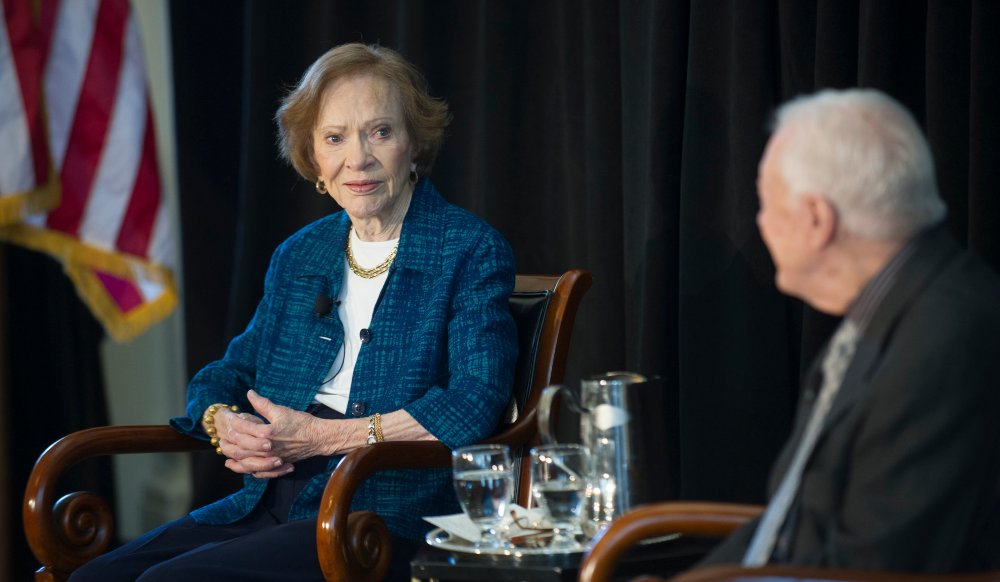Rosalynn Carter was en route to Japan that day. It was half a dozen years after 1980, when Jimmy Carter lost the presidency to Ronald Reagan. Mrs. Carter had several hours layover before for her Alaska Airline flight to Narita. She had set aside an hour as an opportunity to meet with someone from the local press.
J. D. Alexander, the Seattle Post-Intelligencer editor at the time, alerted me (I was the P-I’s city columnist). I wasted little time getting to Sea-Tac, finding the Alaska lounge, and locating the by-now familiar face of Rosalynn Carter.
Mrs. Carter was impeccably dressed in an understated suit with a lace-edged blouse. You might easily mistake her for a businesswoman, traveling to meet with a board of directors. She appeared relaxed and at ease, fully in the present, even though she must have been traveling for some time from her home in Plains, Georgia.
After I introduced myself, we exchanged pleasantries. She volunteered that it was always a thrill to fly into the Seattle area, with the breathtaking views of Mount Rainier and the vast temperate forest.
I asked her how she was adjusting to life after the White House. She said that she “missed the people” more than she missed the daily routine. During Jimmy’s presidency, she had attended Cabinet meetings and had worked with staffers. She had carried a briefcase to her office in the West Wing daily and met with officials and visiting dignitaries.
She allowed that it was good not to be always on stage and in the public eye. It was good, also, for the man she called “Jimmy” not to carry the immense weight of world crises. She acknowledged their final days in the White House — faced with the Iranian hostage crisis – had been very tense. The urge to do what one could to bring the hostages home mattered, she said, far more than winning an election.
But she quickly drew the conversation back to the main reason for her travel: she said she was going to Japan on behalf of Habitat for Humanity, the global nonprofit housing organization that works across states and countries. At that time Habitat was being introduced in Japan. She said she would be “working as a volunteer, helping to build housing.” The Habitat model enlists volunteers who work alongside the prospective homeowners, “building homes and a world where everyone has a decent place to live.”
Mrs. Carter was evangelical about her involvement with Habitat as well as the work she began in the White House on mental health care. Our time together was short, as they had begun calling her plane. But we did have enough time to bid goodbye. It was when she extended her hand to me that I saw a sight I would never forget. Her fingers were scarred and callused. These were not the hands that matched that chic traveling outfit, but hands that had hammered nails and raised roof beams.
Discover more from Post Alley
Subscribe to get the latest posts sent to your email.

I first heard Rosalynn Carter speak about mental health at an event I was covering. She was a tireless and gracious advocate who continued throughout her long life to work to ease the stigma of mental health. I came to DC after she was no longer in the White House, but whenever she returned to the nation’s capital it often was to speak out about mental health issues. Having covered other First Ladies in later years, it’s clear to see how Rosalynn Carter helped to shape the role. It became expected that future First Ladies would use the bully pulpit of their position to promote a cause of their choosing. But while those that have followed Rosalynn Carter may have embraced a specific issue while in office, did they continue with that work after leaving the White House? Rosalynn Carter did, and that’s why her impact lasted well beyond her years at 1600 Pennsylvania Avenue.
Very gracious tribute, Jean. Thanks for sharing that moment.
I met her — along with many other people waiting to talk to her — years ago when I lived in D.C. and worked on the Hill. Though she was obviously exhausted that day, she radiated kindness.
Yes, this is a beautifully written tribute. This graceful sentence stands out to me; “Our time together was short, as they had begun calling her plane. But we did have enough time to bid goodbye. ”
Great piece.
Beautiful. Thank you.
Excellent tribute, you description painted a strong picture of Mrs. Carter
When thinking of the gracious Carters, I hope they both hear “Well done good and faithful servant.”